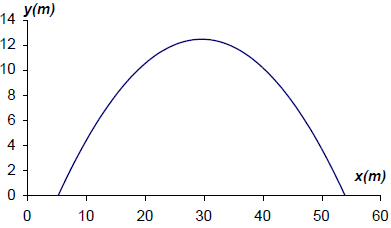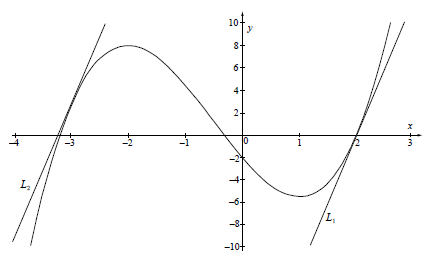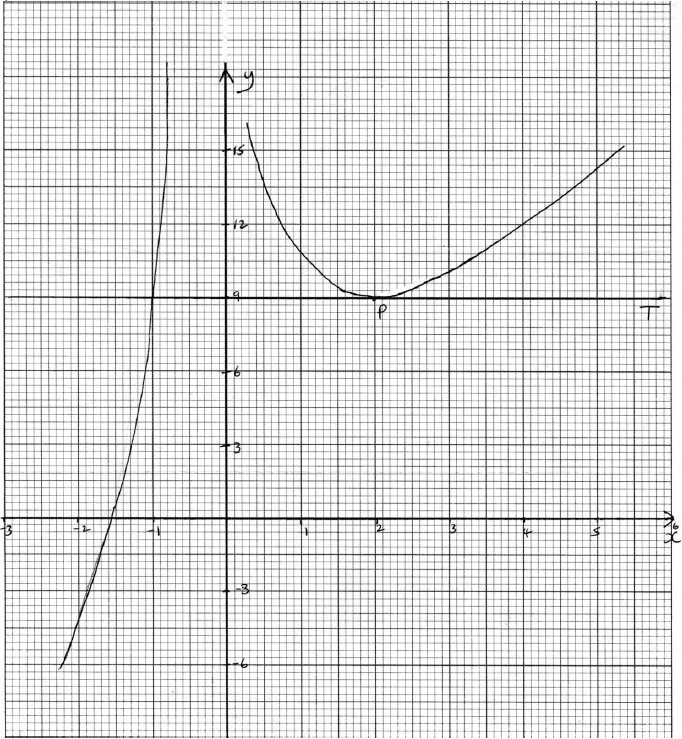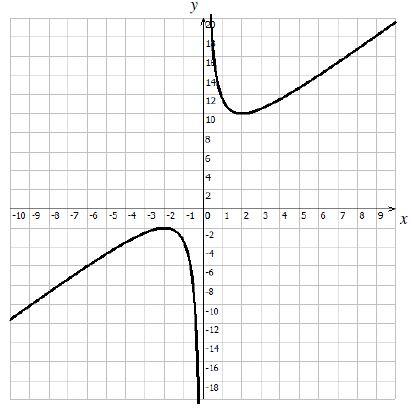Question
Given \(f (x) = x^2 − 3x^{−1}, x \in {\mathbb{R}}, – 5 \leqslant x \leqslant 5, x \ne 0\),
A football is kicked from a point A (a, 0), 0 < a < 10 on the ground towards a goal to the right of A.
The ball follows a path that can be modelled by part of the graph
\(y = − 0.021x^2 + 1.245x − 6.01, x \in {\mathbb{R}}, y \geqslant 0\).
x is the horizontal distance of the ball from the origin
y is the height above the ground
Both x and y are measured in metres.
Write down the equation of the vertical asymptote.[1]
Find \(f ′(x)\).[2]
Using your graphic display calculator or otherwise, write down the coordinates of any point where the graph of \(y = f (x)\) has zero gradient.[2]
Write down all intervals in the given domain for which \(f (x)\) is increasing.[3]
Using your graphic display calculator or otherwise, find the value of a.[1]
Find \(\frac{{dy}}{{dx}}\).[2]
(i) Use your answer to part (b) to calculate the horizontal distance the ball has travelled from A when its height is a maximum.
(ii) Find the maximum vertical height reached by the football.[4]
Draw a graph showing the path of the football from the point where it is kicked to the point where it hits the ground again. Use 1 cm to represent 5 m on the horizontal axis and 1 cm to represent 2 m on the vertical scale.[4]
The goal posts are 35 m from the point where the ball is kicked.
At what height does the ball pass over the goal posts?[2]
Answer/Explanation
Markscheme
equation of asymptote is x = 0 (A1)
(Must be an equation.)
[1 mark]
\(f ‘(x) = 2x + 3x^{-2}\) (or equivalent) (A1) for each term (A1)(A1)
[2 marks]
stationary point (–1.14, 3.93) (G1)(G1)(ft)
(-1,4) or similar error is awarded (G0)(G1)(ft). Here and also as follow through in part (d) accept exact values \( – {\left( {\frac{3}{2}} \right)^{\frac{1}{3}}}\)for the x coordinate and \(3{\left( {\frac{3}{2}} \right)^{\frac{2}{3}}}\) for the y coordinate.
OR \(2x + \frac{3}{{{x^2}}} = 0\) or equivalent
Correct coordinates as above (M1)
Follow through from candidate’s \(f ′(x)\). (A1)(ft)
[2 marks]
In all alternative answers for (d), follow through from candidate’s x coordinate in part (c).
Alternative answers include:
–1.14 ≤ x < 0, 0 < x < 5 (A1)(A1)(ft)(A1)
OR [–1.14,0), (0,5)
Accept alternative bracket notation for open interval ] [. (Union of these sets is not correct, award (A2) if all else is right in this case.)
OR \( – 1.14 \leqslant x < 5,x \ne 0\)
In all versions 0 must be excluded (A1). -1.14 must be the left bound . 5 must be the right bound (A1). For \(x \geqslant – 1.14\) or \(x > – 1.14\) alone, award (A1). For \( – 1.4 \leqslant x < 0\) together with \(x > 0\) award (A2).
[3 marks]
a = 5.30 (3sf) (Allow (5.30, 0) but 5.3 receives an (AP).) (A1)
[1 mark]
\(\frac{{{\text{d}}y}}{{{\text{d}}x}} = – 0.042x + 1.245\) (A1) for each term. (A1)(A1)
[2 marks]
Unit penalty (UP) is applicable where indicated in the left hand column.
(i) Maximum value when \(f ‘ (x) = 0\), \( – 0.042x + 1.245 = 0\), (M1)
(M1) is for either of the above but at least one must be seen.
(x = 29.6.)
Football has travelled 29.6 – 5.30 = 24.3 m (3sf) horizontally. (A1)(ft)
For answer of 24.3 m with no working or for correct subtraction of 5.3 from candidate’s x-coordinate at the maximum (if not 29.6), award (A1)(d).
(UP) (ii) Maximum vertical height, f (29.6) = 12.4 m (M1)(A1)(ft)(G2)
(M1) is for substitution into f of a value seen in part (c)(i). f(24.3) with or without evaluation is awarded (M1)(A0). For any other value without working, award (G0). If lines are seen on the graph in part (d) award (M1) and then (A1) for candidate’s value \( \pm 0.5\) (3sf not required.)
[4 marks]
(not to scale)
 (A1)(A1)(A1)(ft)(A1)(ft)
(A1)(A1)(A1)(ft)(A1)(ft)
Award (A1) for labels (units not required) and scale, (A1)(ft) for max(29.6,12.4), (A1)(ft) for x-intercepts at 5.30 and 53.9, (all coordinates can be within 0.5), (A1) for well-drawn parabola ending at the x-intercepts.
[4 marks]
Unit penalty (UP) is applicable where indicated in the left hand column.
(UP) f (40.3) = 10.1 m (3sf).
Follow through from (a). If graph used, award (M1) for lines drawn and (A1) for candidate’s value \( \pm 0.5\). (3sf not required). (M1)(A1)(ft)(G2)
[2 marks]
Question
Consider the curve \(y = {x^3} + \frac{3}{2}{x^2} – 6x – 2\) .
(i) Write down the value of \(y\) when \(x\) is \(2\).
(ii) Write down the coordinates of the point where the curve intercepts the \(y\)-axis.[3]
Sketch the curve for \( – 4 \leqslant x \leqslant 3\) and \( – 10 \leqslant y \leqslant 10\). Indicate clearly the information found in (a).[4]
Find \(\frac{{{\text{d}}y}}{{{\text{d}}x}}\) .[3]
Let \({L_1}\) be the tangent to the curve at \(x = 2\).
Let \({L_2}\) be a tangent to the curve, parallel to \({L_1}\).
(i) Show that the gradient of \({L_1}\) is \(12\).
(ii) Find the \(x\)-coordinate of the point at which \({L_2}\) and the curve meet.
(iii) Sketch and label \({L_1}\) and \({L_2}\) on the diagram drawn in (b).[8]
It is known that \(\frac{{{\text{d}}y}}{{{\text{d}}x}} > 0\) for \(x < – 2\) and \(x > b\) where \(b\) is positive.
(i) Using your graphic display calculator, or otherwise, find the value of \(b\).
(ii) Describe the behaviour of the curve in the interval \( – 2 < x < b\) .
(iii) Write down the equation of the tangent to the curve at \(x = – 2\).[5]
Answer/Explanation
Markscheme
(i) \(y = 0\) (A1)
(ii) \((0{\text{, }}{- 2})\) (A1)(A1)
Note: Award (A1)(A0) if brackets missing.
OR
\(x = 0{\text{, }}y = – 2\) (A1)(A1)
Note: If coordinates reversed award (A0)(A1)(ft). Two coordinates must be given.
[3 marks]
 (A4)
(A4)
Notes: (A1) for appropriate window. Some indication of scale on the \(x\)-axis must be present (for example ticks). Labels not required. (A1) for smooth curve and shape, (A1) for maximum and minimum in approximately correct position, (A1) for \(x\) and \(y\) intercepts found in (a) in approximately correct position.
[4 marks]
\(\frac{{{\text{d}}y}}{{{\text{d}}x}} = 3{x^2} + 3x – 6\) (A1)(A1)(A1)
Note: (A1) for each correct term. Award (A1)(A1)(A0) at most if any other term is present.
[3 marks]
(i) \(3 \times 4 + 3 \times 2 – 6 = 12\) (M1)(A1)(AG)
Note: (M1) for using the derivative and substituting \(x = 2\) . (A1) for correct (and clear) substitution. The \(12\) must be seen.
(ii) Gradient of \({L_2}\) is \(12\) (can be implied) (A1)
\(3{x^2} + 3x – 6 = 12\) (M1)
\(x = – 3\) (A1)(G2)
Note: (M1) for equating the derivative to \(12\) or showing a sketch of the derivative together with a line at \(y = 12\) or a table of values showing the \(12\) in the derivative column.
(iii) (A1) for \({L_1}\) correctly drawn at approx the correct point (A1)
(A1) for \({L_2}\) correctly drawn at approx the correct point (A1)
(A1) for 2 parallel lines (A1)
Note: If lines are not labelled award at most (A1)(A1)(A0). Do not accept 2 horizontal or 2 vertical parallel lines.
[8 marks]
(i) \(b = 1\) (G2)
(ii) The curve is decreasing. (A1)
Note: Accept any valid description.
(iii) \(y = 8\) (A1)(A1)(G2)
Note: (A1) for “\(y =\) a constant”, (A1) for \(8\).
[5 marks]
Question
Consider the function \(f(x) = 3x + \frac{{12}}{{{x^2}}},{\text{ }}x \ne 0\).
Differentiate \(f (x)\) with respect to \(x\).[3]
Calculate \(f ′(x)\) when \(x = 1\).[2]
Use your answer to part (b) to decide whether the function, \(f\) , is increasing or decreasing at \(x = 1\). Justify your answer.[2]
Solve the equation \(f ′(x) = 0\).[3]
The graph of f has a local minimum at point P. Let T be the tangent to the graph of f at P.
Write down the coordinates of P.[2]
The graph of f has a local minimum at point P. Let T be the tangent to the graph of f at P.
Write down the gradient of T.[1]
The graph of f has a local minimum at point P. Let T be the tangent to the graph of f at P.
Write down the equation of T.[2]
Sketch the graph of the function f, for −3 ≤ x ≤ 6 and −7 ≤ y ≤ 15. Indicate clearly the point P and any intercepts of the curve with the axes.[4]
On your graph draw and label the tangent T.[2]
T intersects the graph of f at a second point. Write down the x-coordinate of this point of intersection.[1]
Answer/Explanation
Markscheme
\(f’ (x) = 3 – \frac{24}{x^3}\) (A1)(A1)(A1)
Note: Award (A1) for 3, (A1) for –24, (A1) for x3 (or x−3). If extra terms present award at most (A1)(A1)(A0).
[3 marks]
\(f ‘(1) = -21\) (M1)(A1)(ft)(G2)
Note: (ft) from their derivative only if working seen.
[2 marks]
Derivative (gradient, slope) is negative. Decreasing. (R1)(A1)(ft)
Note: Do not award (R0)(A1).
[2 marks]
\(3 – \frac{{24}}{{{x^3}}} = 0\) (M1)
\(x^3 = 8\) (A1)
\(x = 2\) (A1)(ft)(G2)
[3 marks]
(2, 9) (Accept x = 2, y = 9) (A1)(A1)(G2)
Notes: (ft) from their answer in (d).
Award (A1)(A0) if brackets not included and not previously penalized.
[2 marks]
0 (A1)
[1 mark]
y = 9 (A1)(A1)(ft)(G2)
Notes: Award (A1) for y = constant, (A1) for 9.
Award (A1)(ft) for their value of y in (e)(i).
[2 marks]
 (A4)
(A4)
Notes: Award (A1) for labels and some indication of scale in the stated window.
Award (A1) for correct general shape (curve must be smooth and must not cross the y-axis).
Award (A1) for x-intercept seen in roughly the correct position.
Award (A1) for minimum (P).
[4 marks]
Tangent drawn at P (line must be a tangent and horizontal). (A1)
Tangent labeled T. (A1)
Note: (ft) from their tangent equation only if tangent is drawn and answer is consistent with graph.
[2 marks]
x = −1 (G1)(ft)
[1 mark]
Question
A function is defined by \(f(x) = \frac{5}{{{x^2}}} + 3x + c,{\text{ }}x \ne 0,{\text{ }}c \in \mathbb{Z}\).
Write down an expression for \(f ′(x)\).[4]
Consider the graph of f. The graph of f passes through the point P(1, 4).
Find the value of c.[2]
There is a local minimum at the point Q.
Find the coordinates of Q.[4]
There is a local minimum at the point Q.
Find the set of values of x for which the function is decreasing.[3]
Let T be the tangent to the graph of f at P.
Show that the gradient of T is –7.[2]
Let T be the tangent to the graph of f at P.
Find the equation of T.[2]
T intersects the graph again at R. Use your graphic display calculator to find the coordinates of R.[2]
Answer/Explanation
Markscheme
\(f'(x) = \frac{{ – 10}}{{{x^3}}} + 3\) (A1)(A1)(A1)(A1)
Note: Award (A1) for −10, (A1) for x3 (or x−3), (A1) for 3, (A1) for no other constant term.
[4 marks]
4 = 5 + 3 + c (M1)
Note: Award (M1) for substitution in f (x).
c = −4 (A1)(G2)
[2 marks]
\(f ‘(x) = 0\) (M1)
\(0 = \frac{{ – 10}}{{{x^3}}} + 3\) (A1)(ft)
(1.49, 2.72) (accept x = 1.49 y = 2.72) (A1)(ft)(A1)(ft)(G3)
Notes: If answer is given as (1.5, 2.7) award (A0)(AP)(A1).
Award at most (M1)(A1)(A1)(A0) if parentheses not included. (ft) from their (a).
If no working shown award (G2)(G0) if parentheses are not included.
OR
Award (M2) for sketch, (A1)(ft)(A1)(ft) for correct coordinates. (ft) from their (b). (M2)(A1)(ft)(A1)(ft)
Note: Award at most (M2)(A1)(ft)(A0) if parentheses not included.
[4 marks]
0 < x < 1.49 OR 0 < x ≤ 1.49 (A1)(A1)(ft)(A1)
Notes: Award (A1) for 0, (A1)(ft) for 1.49 and (A1) for correct inequality signs.
(ft) from their x value in (c) (i).
[3 marks]
For P(1, 4) \(f ‘(1) = – 10 + 3\) (M1)(A1)
\(= -7\) (AG)
Note: Award (M1) for substituting \(x = 1\) into their \(f ‘(x)\). (A1) for \(-10 + 3\).
\(-7\) must be seen for (A1) to be awarded.
[2 marks]
\(4 = -7 \times 1 + c\) \(11 = c\) (A1)
\(y = -7 x + 11\) (A1)
[2 marks]
Point of intersection is R(−0.5, 14.5) (A1)(ft)(A1)(ft)(G2)(ft)
Notes: Award (A1) for the x coordinate, (A1) for the y coordinate.
Allow (ft) from candidate’s (d)(ii) equation and their (b) even with no working seen.
Award (A1)(ft)(A0) if brackets not included and not previously penalised.
[2 marks]
Question
The function \(f(x)\) is defined by \(f(x) = 1.5x + 4 + \frac{6}{x}{\text{, }}x \ne 0\) .
Write down the equation of the vertical asymptote.[2]
Find \(f'(x)\) .[3]
Find the gradient of the graph of the function at \(x = – 1\).[2]
Using your answer to part (c), decide whether the function \(f(x)\) is increasing or decreasing at \(x = – 1\). Justify your answer.[2]
Sketch the graph of \(f(x)\) for \( – 10 \leqslant x \leqslant 10\) and \( – 20 \leqslant y \leqslant 20\) .[4]
\({{\text{P}}_1}\) is the local maximum point and \({{\text{P}}_2}\) is the local minimum point on the graph of \(f(x)\) .
Using your graphic display calculator, write down the coordinates of
(i) \({{\text{P}}_1}\) ;
(ii) \({{\text{P}}_2}\) .[4]
Using your sketch from (e), determine the range of the function \(f(x)\) for \( – 10 \leqslant x \leqslant 10\) .[3]
Answer/Explanation
Markscheme
\(x = 0\) (A1)(A1)
Note: Award (A1) for \(x = {\text{constant}}\), (A1) for \(0\).
[2 marks]
\(f'(x) = 1.5 – \frac{6}{{{x^2}}}\) (A1)(A1)(A1)
Notes: Award (A1) for \(1.5\), (A1) for \( – 6\), (A1) for \({x^{ – 2}}\) . Award (A1)(A1)(A0) at most if any other term present.
[3 marks]
\(1.5 – \frac{6}{{( – 1)}}\) (M1)
\( = – 4.5\) (A1)(ft)(G2)
Note: Follow through from their derivative function.
[2 marks]
Decreasing, the derivative (gradient or slope) is negative (at \(x = – 1\)) (A1)(R1)(ft)
Notes: Do not award (A1)(R0). Follow through from their answer to part (c).
[2 marks]
 (A4)
(A4)
Notes: Award (A1) for labels and some indication of scales and an appropriate window.
Award (A1) for correct shape of the two unconnected, and smooth branches.
Award (A1) for the maximum and minimum points in the approximately correct positions.
Award (A1) for correct asymptotic behaviour at \(x = 0\) .
Notes: Please be rigorous.
The axes need not be drawn with a ruler.
The branches must be smooth and single continuous lines that do not deviate from their proper direction.
The max and min points must be symmetrical about point \((0{\text{, }}4)\) .
The \(y\)-axis must be an asymptote for both branches.
[4 marks]
(i) \(( – 2{\text{, }} – 2)\) or \(x = – 2\), \(y = – 2\) (G1)(G1)
(ii) \((2{\text{, }}10)\) or \(x = 2\), \(y = 10\) (G1)(G1)
[4 marks]
\(\{ – 2 \geqslant y\} \) or \(\{ y \geqslant 10\} \) (A1)(A1)(ft)(A1)
Notes: (A1)(ft) for \(y > 10\) or \(y \geqslant 10\) . (A1)(ft) for \(y < – 2\) or \(y \leqslant – 2\) . (A1) for weak (non-strict) inequalities used in both of the above. Follow through from their (e) and (f).
[3 marks]
